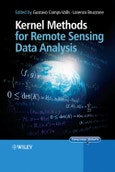Presenting the theoretical foundations of kernel methods (KMs) relevant to the remote sensing domain, this book serves as a practical guide to the design and implementation of these methods. Five distinct parts present state-of-the-art research related to remote sensing based on the recent advances in kernel methods, analysing the related methodological and practical challenges:
- Part I introduces the key concepts of machine learning for remote sensing, and the theoretical and practical foundations of kernel methods.
- Part II explores supervised image classification including Super Vector Machines (SVMs), kernel discriminant analysis, multi-temporal image classification, target detection with kernels, and Support Vector Data Description (SVDD) algorithms for anomaly detection.
- Part III looks at semi-supervised classification with transductive SVM approaches for hyperspectral image classification and kernel mean data classification.
- Part IV examines regression and model inversion, including the concept of a kernel unmixing algorithm for hyperspectral imagery, the theory and methods for quantitative remote sensing inverse problems with kernel-based equations, kernel-based BRDF (Bidirectional Reflectance Distribution Function), and temperature retrieval KMs.
- Part V deals with kernel-based feature extraction and provides a review of the principles of several multivariate analysis methods and their kernel extensions.
This book is aimed at engineers, scientists and researchers involved in remote sensing data processing, and also those working within machine learning and pattern recognition.
Table of Contents
About the editors.List of authors.
Preface.
Acknowledgments.
List of symbols.
List of abbreviations.
I Introduction.
1 Machine learning techniques in remote sensing data analysis (Bjorn Waske, Mathieu Fauvel, Jon Atli Benediktsson and Jocelyn Chanussot).
1.1 Introduction.
1.2 Supervised classification: algorithms and applications.
1.3 Conclusion.
Acknowledgments.
References.
2 An introduction to kernel learning algorithms (Peter V. Gehler and Bernhard Scholkopf).
2.1 Introduction.
2.2 Kernels.
2.3 The representer theorem.
2.4 Learning with kernels.
2.5 Conclusion.
References.
II Supervised image classification.
3 The Support Vector Machine (SVM) algorithm for supervised classification of hyperspectral remote sensing data (J. Anthony Gualtieri).
3.1 Introduction.
3.2 Aspects of hyperspectral data and its acquisition.
3.3 Hyperspectral remote sensing and supervised classification.
3.4 Mathematical foundations of supervised classification.
3.5 From structural risk minimization to a support vector machine algorithm.
3.6 Benchmark hyperspectral data sets.
3.7 Results.
3.8 Using spatial coherence.
3.9 Why do SVMs perform better than other methods?
3.10 Conclusions.
References.
4 On training and evaluation of SVM for remote sensing applications (Giles M. Foody).
4.1 Introduction.
4.2 Classification for thematic mapping.
4.3 Overview of classification by a SVM.
4.4 Training stage.
4.5 Testing stage.
4.6 Conclusion.
Acknowledgments.
References.
5 Kernel Fisher’s Discriminant with heterogeneous kernels (M. Murat Dundar and Glenn Fung).
5.1 Introduction.
5.2 Linear Fisher’s Discriminant.
5.3 Kernel Fisher Discriminant.
5.4 Kernel Fisher’s Discriminant with heterogeneous kernels.
5.5 Automatic kernel selection KFD algorithm.
5.6 Numerical results.
5.7 Conclusion.
References.
6 Multi-temporal image classification with kernels (Jordi Muñoz-Marí, Luis Gómez-Choa, Manel Martínez-Ramón, José Luis Rojo-Álvarez, Javier Calpe-Maravilla and Gustavo Camps-Valls).
6.1 Introduction.
6.2 Multi-temporal classification and change detection with kernels.
6.3 Contextual and multi-source data fusion with kernels.
6.4 Multi-temporal/-source urban monitoring.
6.5 Conclusions.
Acknowledgments.
References.
7 Target detection with kernels (Nasser M. Nasrabadi).
7.1 Introduction.
7.2 Kernel learning theory.
7.3 Linear subspace-based anomaly detectors and their kernel versions.
7.4 Results.
7.5 Conclusion.
References.
8 One-class SVMs for hyperspectral anomaly detection (Amit Banerjee, Philippe Burlina and Chris Diehl).
8.1 Introduction.
8.2 Deriving the SVDD.
8.3 SVDD function optimization.
8.4 SVDD algorithms for hyperspectral anomaly detection.
8.5 Experimental results.
8.6 Conclusions.
References.
III Semi-supervised image classification.
9 A domain adaptation SVM and a circular validation strategy for land-cover maps updating (Mattia Marconcini and Lorenzo Bruzzone).
9.1 Introduction.
9.2 Literature survey.
9.3 Proposed domain adaptation SVM.
9.4 Proposed circular validation strategy.
9.5 Experimental results.
9.6 Discussions and conclusion.
References.
10 Mean kernels for semi-supervised remote sensing image classification (Luis Gómez-Chova, Javier Calpe-Maravilla, Lorenzo Bruzzone and Gustavo Camps-Valls).
10.1 Introduction.
10.2 Semi-supervised classification with mean kernels.
10.3 Experimental results.
10.4 Conclusions.
Acknowledgments.
References.
IV Function approximation and regression.
11 Kernel methods for unmixing hyperspectral imagery (Joshua Broadwater, Amit Banerjee and Philippe Burlina).
11.1 Introduction.
11.2 Mixing models.
11.3 Proposed kernel unmixing algorithm.
11.4 Experimental results of the kernel unmixing algorithm.
11.5 Development of physics-based kernels for unmixing.
11.6 Physics-based kernel results.
11.7 Summary.
References.
12 Kernel-based quantitative remote sensing inversion (Yanfei Wang, Changchun Yang and Xiaowen Li).
12.1 Introduction.
12.2 Typical kernel-based remote sensing inverse problems.
12.3 Well-posedness and ill-posedness.
12.4 Regularization.
12.5 Optimization techniques.
12.6 Kernel-based BRDF model inversion.
12.7 Aerosol particle size distribution function retrieval.
12.8 Conclusion.
Acknowledgments.
References.
13 Land and sea surface temperature estimation by support vector regression (Gabriele Moser and Sebastiano B. Serpico).
13.1 Introduction.
13.2 Previous work.
13.3 Methodology.
13.4 Experimental results.
13.5 Conclusions.
Acknowledgments.
References.
V Kernel-based feature extraction.
14 Kernel multivariate analysis in remote sensing feature extraction (Jerónimo Arenas-Garciá and Kaare Brandt Petersen).
14.1 Introduction.
14.2 Multivariate analysis methods.
14.3 Kernel multivariate analysis.
14.4 Sparse Kernel OPLS.
14.5 Experiments: pixel-based hyperspectral image classification.
14.6 Conclusions.
Acknowledgments.
References.
15 KPCA algorithm for hyperspectral target/anomaly detection (Yanfeng Gu).
15.1 Introduction.
15.2 Motivation.
15.3 Kernel-based feature extraction in hyperspectral images.
15.4 Kernel-based target detection in hyperspectral images.
15.5 Kernel-based anomaly detection in hyperspectral images.
15.6 Conclusions.
Acknowledgments
References.
16 Remote sensing data Classification with kernel nonparametric feature extractions (Bor-Chen Kuo, Jinn-Min Yang and Cheng-Hsuan Li).
16.1 Introduction.
16.2 Related feature extractions.
16.3 Kernel-based NWFE and FLFE.
16.4 Eigenvalue resolution with regularization.
16.5 Experiments.
16.6 Comments and conclusions.
References.
Index.
Samples

LOADING...








